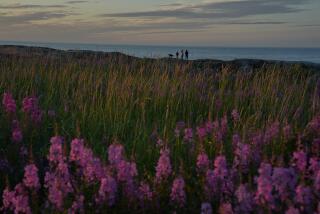Canada responds to caribou decline with plan to kill wolves
- Share via
Woodland caribou herds in Canada are declining, and tar sands development is a big part of the reason why. But Canada’s national and provincial governments know what do about that: Kill the wolves.
That’s the crux of new posts by both Grist and the National Wildlife Federation, which are following this issue. Both are revisiting the environmental costs of tar sands development in Alberta.
The federation cites numerous studies released in 2011 that found that oil and gas development in Canada is contributing to the decline of woodland caribou herds. Both the national government and the province of Alberta acknowledge that tar sands development adversely affects the herds.
Environment Canada, the country’s national environmental agency, announced in fall 2011 that a draft of a nationwide caribou recovery plan – which is not yet in effect – would include plans to cull the wolf population near the three herds that are directly affected by the tar sands development. Environment minister Peter Kent was quoted in numerous stories acknowledging that “thousands” of wolves might need to be killed. Many stories have focused on the use of strychnine poisoning and aerial hunting to kill the wolves.
Officials in Alberta, however, want to emphasize that this program has not yet begun and, while wolves are currently controlled in the province, that images of a wholesale wolf slaughter are overblown.
“This is quite an egregious misrepresentation of how we do predator management when we do have to do some of this,” said Dave Ealey, spokesman for Alberta Sustainable Resource Development, a bureau of the provincial government of Alberta. Yes, he acknowledged, the province does kill wolves, usually in response to attacks on livestock, and they do use “toxics.” They are also using aerial hunting to aid the caribou in the west-central area of the province, where other oil and gas developments (not the tar sands) have negatively affected the caribou.
However, he said, the number of wolves in the province is not being decreased.
“We haven’t reduced any number of wolves,” Ealey added. “We have parts of the boreal forest where there are some development activities that change the habitat that makes it more attractive to other prey, like deer, moose and elk. The increased alternative prey provides food for wolves and the wolf population increases as a result.” He also noted that wildfires can have the same effect, making the habitat unsuitable for caribou, but other prey species move in and the wolves respond.
Alberta has a reported 18 herds or populations of woodland caribou in the province. These are not the vast, migrating caribou herds seen in Alaska, but small groups more easily affected by habitat loss.
Mark Johnson, a spokesman for Environment Canada, acknowledged the plight of the caribou, writing in an emailed response: “Our evidence indicates that Alberta’s boreal woodland caribou herds are at a high risk of extirpation.” Meaning, to die out locally. He added, “There is a strong correlation between self-sustainability of caribou herds and the amount of habitat disturbance (both man-made and natural disturbance) on the landscape.”
A four-year study led by Samuel Wasser, director of the Center for Conservation Biology at the University of Washington, found in 2011 that the caribou in the area were more threatened by habitat loss because of oil and gas development than they were by wolves. This leaves the province and the Canadian government with hard choices.
Ealey and Johnson emphasized that habitat restoration is part of the caribou recovery plan, though it’s hard to know how that will happen if oil and gas development expands at the current rate.
“Immediate and long-term actions will vary based on habitat and population condition of each range in Alberta, but habitat restoration is expected to be a prominent element in recovery planning for this species,” Johnson said.
RELATED:
Pro-fracking movie gets $22K in two days in Kickstarter campaign
‘Gasland’ director Josh Fox vs. Republican oil lobby
EPA beach pollution rules allow 1 in 28 to get sick






